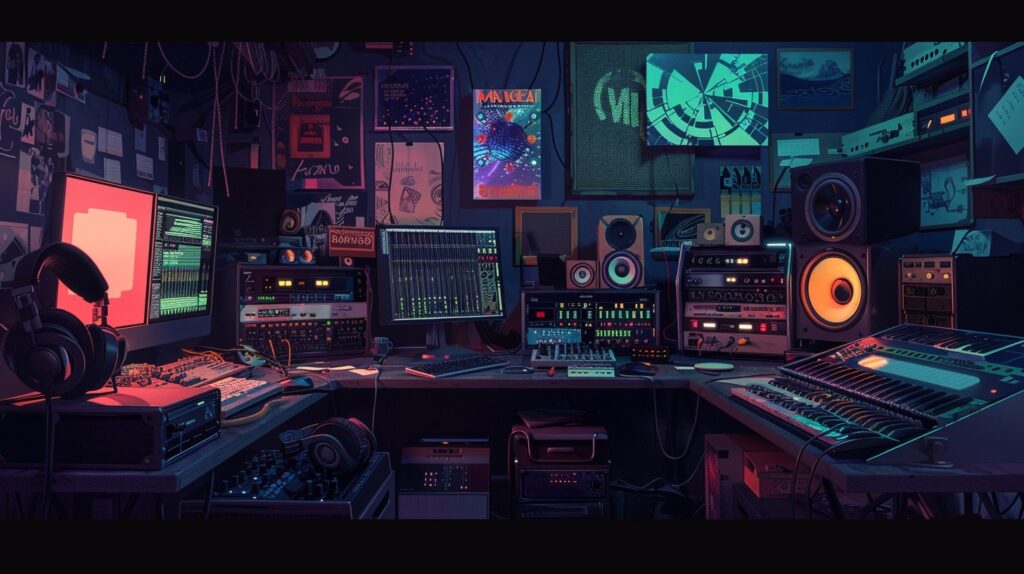When you think about sound design in games, it’s easy to overlook its profound impact on player experience. Yet, as an experienced developer, you know that mastering techniques like audio synchronization and 3D audio spaces can transform a simple interaction into something truly immersive. Consider how emotional sound design not only enhances gameplay but also deepens narrative connections. These elements are essential for crafting unforgettable moments. But what are the specific strategies that make the difference in player engagement? Exploring these could change how you approach your next project significantly.

Understanding Soundscapes
In gaming, soundscapes immerse you in the environment, enhancing your emotional connection and overall experience. You’ll find that a well-crafted soundscape can transport you into a different world, making each moment feel more impactful. Every sound, from ambient noises to character dialogues, plays a crucial role in shaping your perception of the game.
To create an effective soundscape, focus on layering different audio elements. Start with ambient sounds that set the scene—think rustling leaves in a forest or distant traffic in a city. These subtle layers provide context and make the world feel alive.
Next, incorporate sound effects that match the actions occurring on-screen. When you jump or interact with objects, the corresponding sounds should feel natural and responsive.
Don’t overlook the importance of musical scores, either. A dynamic soundtrack can amplify tension during a boss fight or evoke nostalgia in a quiet moment. Remember, your choices in sound design can either support or detract from the narrative.
Advanced Audio Synchronization
Mastering advanced audio synchronization ensures that every sound effect and musical cue aligns perfectly with the on-screen action, creating a seamless and immersive gaming experience. To achieve this, you’ll want to utilize techniques like time-stretching and pitch-shifting, which allow sounds to adapt dynamically to gameplay changes.
Consider implementing a robust audio engine that supports real-time audio manipulation. This way, you can adjust sounds based on player actions or environmental changes without losing quality. Syncing audio to animation also plays a crucial role; using animation curves can help you time sound effects precisely with character movements or environmental events.
Don’t overlook the importance of sample rates and buffer sizes. Higher sample rates yield clearer audio, while appropriately sized buffers minimize latency, ensuring that sounds play exactly when needed. Additionally, employing visual aids like audio waveforms can help you better visualize the timing of your audio, allowing for fine-tuning.
Lastly, rigorous testing is key. Playtest your game multiple times to ensure that all audio elements are in sync, making adjustments as necessary. With these strategies, you’ll elevate your game’s audio experience to new heights.
Emotional Sound Design Techniques
Emotional sound design techniques can deeply enhance player connection by using music, sound effects, and ambient noise to evoke specific feelings during gameplay.
You’ll want to consider the emotional arc of your game and align your audio elements accordingly. For instance, a haunting melody can amplify tension in a suspenseful scene, while uplifting chords can create a sense of triumph after overcoming a challenge.
Using sound effects strategically is crucial. The subtle crackle of a fire or the distant chirping of birds can ground players in the environment, making them feel more immersed.
Layering these sounds can create a rich auditory tapestry that resonates emotionally.
Don’t forget about silence. Sometimes, the absence of sound can be just as powerful, allowing players to process their emotions or heightening anticipation.
Experiment with musical motifs that represent characters or themes, creating an emotional connection that players will remember long after they’ve finished playing.
Utilizing 3D Audio Spaces
Creating immersive 3D audio spaces can dramatically transform how players experience your game, making them feel as if they’re truly part of the environment.
To achieve this, start by using spatial audio techniques that place sounds in a three-dimensional space. This means considering not just left and right channels but also the height and depth of sound. Tools like binaural audio or ambisonics can help you effectively create this spatial awareness.
Next, think about the listener’s position. As players move through your game, sounds should dynamically change based on their proximity and direction. Utilize occlusion and distance effects to simulate how sound behaves in real life—distant sounds should fade, while nearby sounds should be clearer and more pronounced.
Don’t forget to layer your audio. By combining various ambient sounds, you can build a rich soundscape that feels alive. Make sure to incorporate environmental cues, like echoes in a cave or the rustling of leaves in a forest, to enhance realism.
Integrating Sound With Narrative
Sound plays a crucial role in enhancing narrative depth, drawing players deeper into the story and making their experiences more engaging. As you integrate sound with narrative, consider how audio elements can reflect character emotions, setting tone, and build atmosphere. Use music to underscore pivotal moments, guiding players’ feelings and highlighting critical plot points.
Dialogue should be crisp and clear, ensuring players connect with characters and understand their motivations. Think about how ambient sounds—like the rustling of leaves or distant thunder—can create a sense of place and time, immersing players further into the world you’ve crafted.
Dynamic sound design can also respond to player actions, enhancing the narrative experience. For instance, if a player makes a significant choice, a shift in the soundtrack can signal the weight of that decision, reinforcing its impact on the story.
Conclusion
In conclusion, mastering sound design is essential for creating immersive gaming experiences. By understanding soundscapes, employing advanced audio synchronization, and utilizing emotional sound design techniques, you can elevate your games to new heights.
Don’t overlook the power of 3D audio spaces and the seamless integration of sound with narrative. By honing these skills, you’ll not only enhance player immersion but also forge deeper emotional connections, making your games unforgettable.
Dive into the art of sound design and transform your projects!

